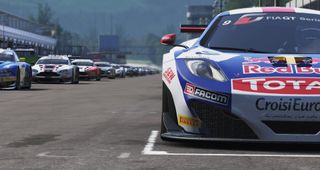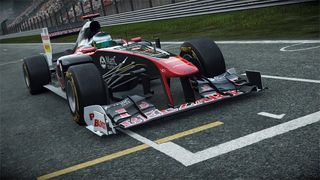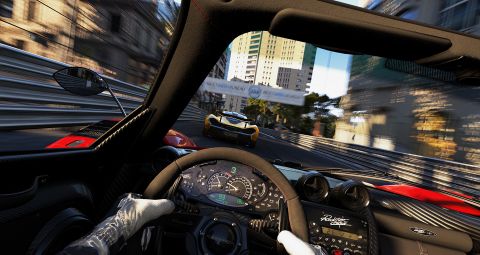PROS
- At times
- it looks as good as real life
- Superb weather system
- Open-ended structure means no unlocking
- Immensely satisfying when you finally win
CONS
- Inconsistent quality across events
- The AI needs a refresher course in how to drive safely
When it all works, Project CARS is so good, it may as well be reality. One Touring Car race I had around Barcelona in the blazing sunshine was so utterly convincing, I felt like I'd actually been there. Even with 30 exquisitely-detailed cars jostling for position around this magnificent, sunshine-drenched, HD circuit, the frame-rate remained smooth and the overall effect equal to real life. It's everything a sim on your new-gen console should be doing: effectively recreating the real world.
If you've ever been to a real race track, you'll know that they're nothing like TV would have you believe. It's surprising how 'outdoorsy' they feel. You are, after all, standing in a field, looking at a ribbon of tarmac surrounded by piles of tyres and concrete kerbs. It's actually much less glamorous than you expect… but then a racing car zooms by and something undeniably magical happens. It's this 'real' experience that's reproduced in Project CARS, and there's nothing even remotely video gamey about it. It's the same feeling, only here it's you doing the driving.

So how is that driving? Well, in a word: difficult. When your tyres are up to a good temperature, there is sufficient grip to allow you reasonable confidence on the accelerator, at which point you can start to push your limits and have some real fun. Thing is, you don't start with hot tyres. If you exit the pits and pull the accelerator while the icons are blue (that means cold, of course), you'll slew into the wall and knacker your suspension. Fact. The practice and qualifying sessions require you to tiptoe around the track like you're on an ice rink (you may as well be) for a lap or two until your tyres are up to temperature. And this is where the AI first shows its suicidal tendencies.
While you're gingerly feeding in the throttle, it's quite normal to get punted into the air and even onto your roof because the AI is unable to avoid a slower car in plain sight. Even during close-fought races, they'll go into the back of you under braking, they'll cut you up on the straights… I would say it's poor awareness of the player, but they do it to each other, too. Most races see mid-pack carnage at the first corner because, quite simply, the AI drives like a buffoon. When the knife edge of control is so thin at the best of times, trying to maintain control in a packed field is impossible and you'll see countless retries as you try to just get a decent start and survive the first lap.

GRAPHICS: ON/OFF

Prior to release, it was noted that the console versions have PC-style graphics settings. The same is true of the final game. But while you can toggle special effects in the options, such as post-processing, lens flares and crepuscular effects, they're all switched on by default except for heat haze. And the frame rate is fine. Nothing to worry about there, then.
Even though the difficulty is so punishing, I would recommend gritting your teeth and just having another go, rather than lowering the settings. Because each time you shave something from that core simulation, the more you compromise the experience. Automatic gears? Sure, less to think about. Visual only damage? Why not? That'll relieve the frustration no end. Mechanical failures? Why would I want random failures on top of my own calamities? Before you know it, it's not a sim any more; it's a feeble, neutered version of the real experience that's on offer. Project CARS goes to such great lengths to simulate every aspect of driving a racing car, it deserves to be played properly. And when you do qualify first and convert it into a win, it feels amazing.
Mind you, when everything is set up so close to reality, anything that isn't 100% naturalistic looks odd. Cars that are flipped onto their roll bars immediately lose inertia, like they're stuck to the track, which is disappointing considering all the other crash physics are so good. Then there are the door-to-door collisions of the classic Mercedes races. A friendly nudge should result in traded paint. Here, it often launches both cars into a roll. The racing is too close to avoid such scrapes and the consequences are too severe.

There are more small annoyances everywhere you look. Considering the fact that the game's target audience is the kind that uses manual gears, the default pad calibration is all kinds of bonkers. Mapping gears up/down to the shoulder buttons while the triggers below them are accel/brake is sheer lunacy. Worse still, it took me 10 minutes to exit the remap controls screen because it doesn't tell you which of the buttons are compulsory, and won't let you exit until you've assigned them. Turns out you need to have the 'look back' button assigned or you can't play. No idea why, especially as the mirrors work beautifully.
Similarly brow-furrowing is the abundance of bugs. I've seen the AI take over control in the pit lane as usual, only to drive into a wall before fumbling for reverse and backing up to have another go. The clouds flicker sometimes, as does the player car in some replays. I've seen the camera spawn in below the circuit, looking up at the undertrays of the cars on the grid. I've been booted back to the Xbox dashboard… even had everything load in except the light sequence, leaving everyone waiting on the grid. Forever.

Given the massive amount of content here, it's unsurprising. It's one of the most ambitious games I've ever seen. There are over 100 track layouts, each with realistic weather and day/night cycles (which are all beautiful to behold) and months' worth of racing to be done, even if you never stray outside of your favourite discipline. It's also very pleasing to discover the game's structure is completely open. You can race on any track in any car in any weather and at any time of day (pause for breath) without having to unlock anything.
To keep even single-discipline seasons fresh, invitationals pop up every now and then, allowing you the chance to try out optional special events. So you'll still get to sample go-karts, Touring Cars, Sports Cars or whatever, even if you've jumped straight into the excellent single-seater tiers. If you like, of course - it's up to you. But I can't help but feel that considering any one of the car types could have been licensed, polished and released as an impressive standalone racer, less probably would have been more.

There are two important questions that I feel I need to address. Firstly, as I know you're wondering: is it actually fun? Answer: hell, yes. Secondly: Will everyone find it fun? Answer: hell, no. You need a certain mindset to get the most out of Project CARS. You need patience, discipline, knowledge of racing theory or at the very least a willingness to learn.
Personally, I love that approach. And the game is undoubtedly made for people like me. It is a landmark for racing sims. Whereas Gran Turismo 6 managed to fool my brain for a few seconds into thinking I was looking at reality, this has entire minutes of perfection where I simply can't believe my eyes. If only it were a little more polished and consistently awesome, it would be a classic.
This game was reviewed on Xbox One.
THE VERDICT
3.5 OUT OF 5
PROJECT CARS
When it works, Project CARS is unbelievably good. But overly-aggressive AI, odd collision physics, imperfect pad controls and several bugs mean it's just shy of greatness.

Comments
Post a Comment